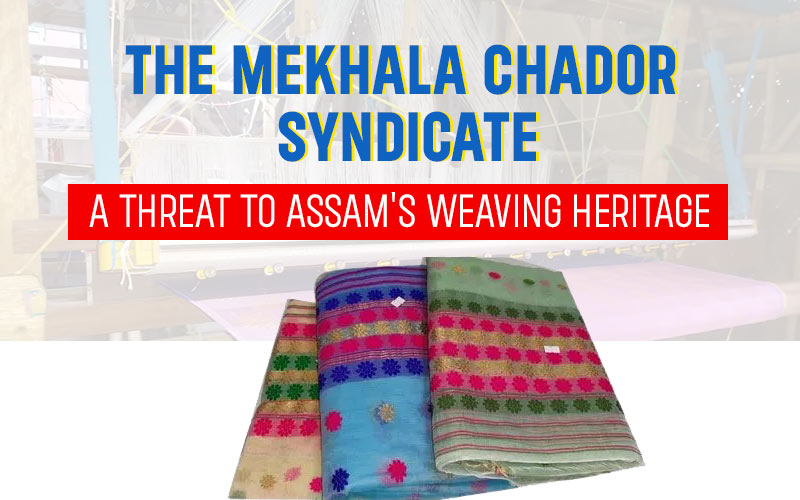
The Mekhala Chador Syndicate: A Threat to Assam's Weaving Heritage
Many would not know about it
because it doesn’t concern most of us. What does it have to do with us?Many
will say. But believe it or not, once a thriving industry in Assam that is
weaving of mekhala chador is rapidly witnessing a decline.
The mekhala chador, a traditional Assamese garment, has been a symbol of the region's rich cultural heritage and a thriving industry for many years. However, this once-flourishing craft is now facing a rapid decline due to the sinister activities of a syndicate, which has taken control of the essential resources needed for its production.
The Crisis Unfolds
The syndicate's
operations revolve around monopolizing the sources of threads required for
weaving Muga and Pat mekhala chadors. By buying up or forcibly acquiring all
the thread production in Assam, they have created an artificial scarcity.The syndicate in
question has taken over major Muga silk suppliers in Upper Assam, including in
districts like Dhemaji, Lakhimpur, Golaghat, Jorhat, and Dibrugarh. The same
control extends to the suppliers of Pat and Eri silk. This
manipulation allows them to sell the threads at exorbitant prices, leaving
indigenous weavers unable to afford the essential materials for their craft.
And the threat is same for saris and gamusas produced in
local handlooms, using cardboard cards punched with intricate designs that
remind one of Braille.
Dinesh
Mahanta, a weaver from Sualkuchi, said: “I have been in this business for 25
years and I have felt that in the last 10 to 15 years, this business is not
doing well at all. We have to buy the raw materials such as silk yarn, which is
expensive, but we are not getting paid for our products as much as we are
spending on the raw materials.”
Impact on Weavers
The increased
cost of production has hit local weavers hard. Many cannot bear the financial
burden and have been forced out of their traditional livelihoods. Those who
manage to continue weaving are compelled to raise their product prices, making
it difficult to compete in the market. The long-term consequence of this
pressure is a looming monopoly by the syndicate, which will control both supply
and pricing, pushing traditional weavers out of the industry entirely.
While
proponents may suggest that weavers can benefit from schemes like the National
Handloom Development Programme (NHDP) and the North-Eastern Region Textile
Promotion Scheme (NERTPS), these initiatives often offer short-term relief.
However, the persistent presence of syndicates creates an uneven playing field.
Consequently, despite initial support, weavers frequently find themselves
succumbing to pressure and unable to sustain their operations in the long term.
Alternatives and Challenges
Some might
suggest sourcing or importing threads from other states as a solution. However,
this is not a viable option for many weavers. The costs associated with
importing are still higher, and the quality of the threads often does not match
the standards required for authentic mekhala chadors.Muga Silk, Pat Silk, and Eri
Silk are produced using specific species of silkworms that are native to Assam
and some other regions of Northeast India. The climatic conditions,
availability of food plants, and other environmental factors play a crucial
role in the production of these silk varieties. Attempting to replicate these
conditions in other states may not yield the same quality of silk. Thus, the core problem remains unresolved.
Sualkuchi: A Shadow of Its Former Self
Sualkuchi, once
heralded as the Manchester of the East, stands as a poignant example of the
industry's decline. This town, renowned for its weaving excellence, now
struggles to maintain its identity. HiralalKalita, a master weaver from
Sualkuchi, said the manufactured handloom products from Sualkuchi no longer
have a high demand. “Sales have dropped and that is because powerlooms have
taken over handlooms. Our items are more expensive because they are
labour-intensive, whereas powerloom-created products look the same and are
cheaper and therefore, people prefer that,” Kalita said.
Many skilled weavers have abandoned their looms in favor of more stable sources of income. The art, culture, and quality that once defined Sualkuchi's weaving industry are being replaced by mass production models that prioritize quantity over quality.
Hope on the Horizon
Despite these challenges, there are glimmers of hope. A number of courageous designers and artisans are fighting to preserve Assam's weaving traditions.
Many designers and manufacturing group specializing in weaving and rural development, has taken a commendable step forward by adopting two villages in Assam. Their objective is to propel Assam silk into a distinguished statement in the traditional wear industry.
These group/individuals support local weavers and promote the unique art and culture embodied in the mekhala chador. However, their efforts are constantly undermined by the syndicate's control. The sustainability of their endeavors remains uncertain as long as the syndicate continues to dominate the market.
The Hidden Culprit
You may be wondering, who is behind this syndicate? While it could be anyone from the local community, what's important is the impact they have on this once-thriving industry. The identity might be whispered among locals, but the true focus should be on dismantling the power they hold over the weaving community.
Instead of fixating on who these individuals are, our energy should be directed towards breaking their stronghold. This syndicate's control disrupts the livelihoods of artisans and threatens the preservation of cultural heritage. By addressing the systemic issues and empowering the weavers, we can restore fairness and prosperity to the industry.
The plight of Assam's mekhala chador weaving industry is a stark reminder of how vulnerable traditional crafts are to modern economic manipulations. Without intervention and support, this traditional craft faces the risk of becoming a lost art. It is imperative for stakeholders, including the government, local communities, and consumers, to come together to address this issue and preserve Assam's rich cultural heritage.
Related stories:
https://thecriticalscript.com/article-details/are-sualkuchis-traditional-weavers-losing-grounds
Disclaimer: The opinions expressed in this article are those of the author's. They do not purport to reflect the opinions or views of The Critical Script or its editor.

Newsletter!!!
Subscribe to our weekly Newsletter and stay tuned.

















Related Comments